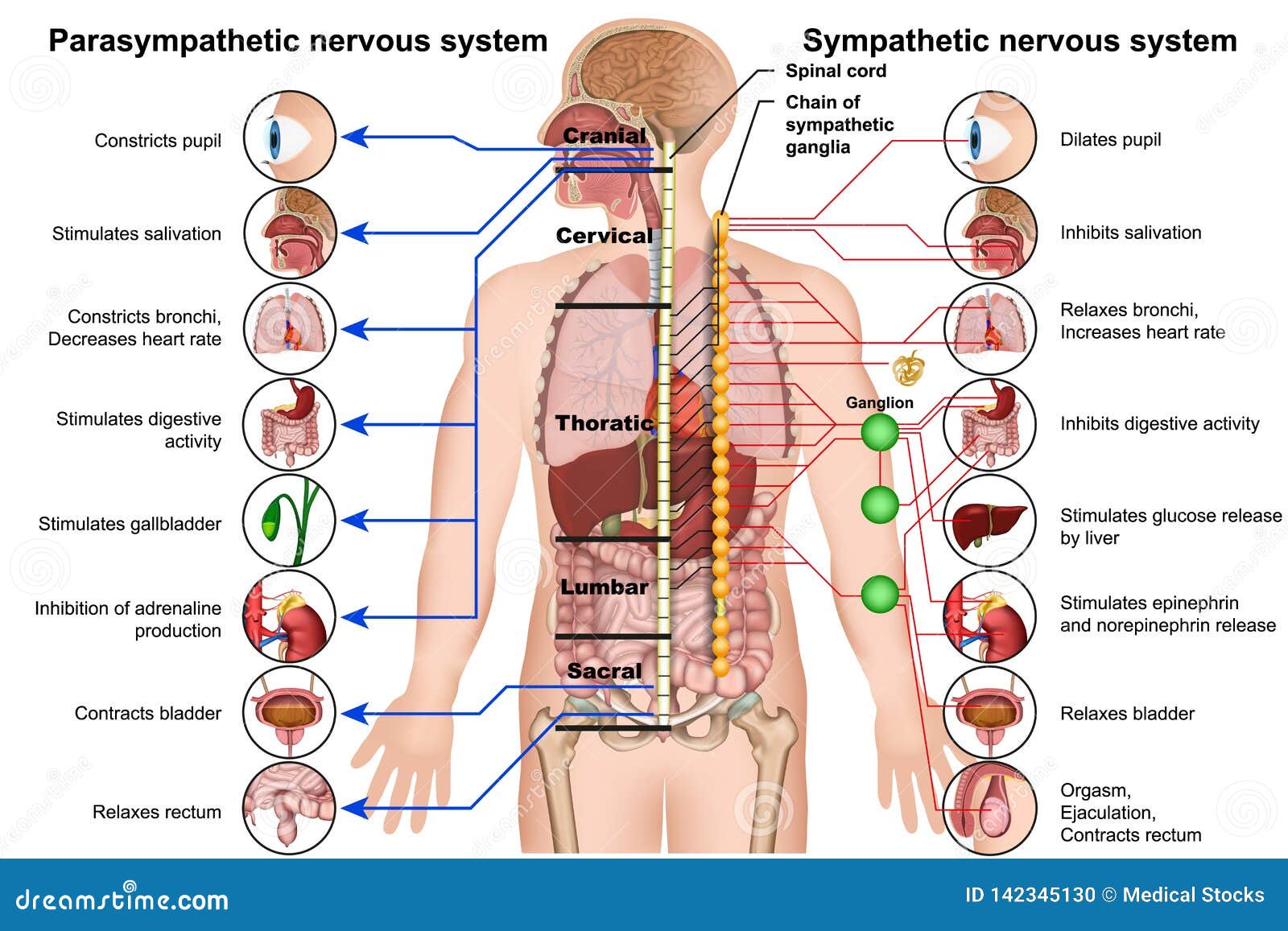The Sympathetic Nervous System
Within the nervous system is the autonomic nervous system, which then contains the sympathetic and parasympathetic nervous systems. These two systems are involuntarily, meaning our body does not have control over what it is performing. The sympathetic nervous system is known as “fight-or-flight”, while parasympathetic is known as “rest and digest”. Even though they are different, these systems still work hand in hand with one another to help control the way our body works. Sympathetic is almost like an alarm clock, as it arouses the body and stimulates the nerves to start working. On the other hand, parasympathetic helps calm the body down, as it brings the body back to its normal state. The sympathetic division is not responsible for physically helping you fight or run, but rather prepares your body for the events it is about to encounter. Meanwhile, the parasympathetic division focuses on influencing our response to the situation so our body can ease back to its usual ways.
When triggered, the sympathetic nervous system carries out certain functions to prepare the body to make a decision within that moment. The symptoms normally experienced in a “fight-or-flight” situation are dilated pupils, accelerated heart rate, rapid breathing, and sweating. With these symptoms, it helps one to see and process information more clearly, transfer more blood to your muscles, and helps fight off whatever it is encountered.

A “fight-or-flight” moment can be experienced in several different ways by anyone. A time in which I experienced a “fight-or-flight” moment was when I was on vacation in the Bahamas in 2018. My family rented out a yacht for the day to sail through Rose Island for fun excursions, such as snorkeling, tubing, jet skiing, and much more. Though something the cabin members always make their guests do is jump off of the highest level of their boat. My brother and I decided to jump together, and off we went from the third level of the boat. After landing in the water, my brother and I noticed a black/grey figure swimming towards us, realizing it was a Stingray. I immediately felt a rush of adrenaline, my heart rate became rapid, my breathing became intense, my body sweating, and I swam as fast as I could back to the boat. Now having an understanding of “fight-or-flight mode”, I realize that in that moment my body was experiencing all the sympathetic symptoms. My only intention was to swim away as fast as I possibly could from the Stingray, therefore showing the use of the “flight” mode to help reach myself to safety.
Once I got back on the boat my body then went through the effects of the parasympathetic system. My heart rate began to slow down, my breathing was not as intense, my pupils constricted, and my body went back to its normal state. I believe my experience demonstrates one of the purposes of the sympathetic nervous system because it describes a memory of when I was in a stressful situation and had to react in a timely manner by using the “flight-or-fight” method. Experiencing the sympathetic nervous system may not always be enjoyable, but with this system it helps our bodies respond to demanding situations and is essentially responsible for controlling what we do in the moment.
:max_bytes(150000):strip_icc()/2795194-article-what-is-the-fight-or-flight-response-5a98601d8e1b6e0036df2951.png)
https://www.verywellmind.com/what-is-the-fight-or-flight-response-2795194
References: Wede, J. (n.d.). Psychology.
Hi Brooke!
Your post on the sympathetic nervous system was very informative. It’s interesting to think about how many different ways the effects of the sympathetic NS show up in our lives. While responses like the stingray encounter you described in your blog show a more extreme case of the “flight” response, I think there are plenty of instances in my own life when my sympathetic system kicks in. For example, after watching a horror movie, I feel my heart rate increase when I’m alone in my room and am wary of any slight sounds or moving shadows. Do you think this counts as a slight response of the body’s sympathetic nervous system? What other examples can you think of in your day-to-day activities where the sympathetic nervous system comes into play?
Hello Brooke!
Your personal experience of flight-or-fight mode is quite interesting. When people are under certain stress or in an intense situation, the flight-or-fight response will kick in. Our sympathetic system will raise our heart rate and other responses like sweating and trembling. Your reactions when encountering the stingray vividly displayed the function of our sympathetic system. I also had similar experience of flight-or-fight mode when going to an interview. I remember when I went to college interviews in high school, my heart raced really fast and I started to sweat a lot with trembling hands. And when I talked to the interviewer, I was a little bit stuttered. I was really nervous during the interview and my sympathetic system was acting under stress. And after the interview was done, my heart rate slowed down a little, and I stopped sweating. This is when my parasympathetic system was functioning. I relate to your experience a lot and find it fascinating.